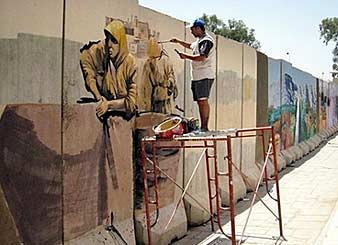On Decorating The Blast Walls

When pondering the above photograph of an artist painting a mural, what comes to mind? That the artist is playing a constructive role in society by creating a public work meant to beautify his community? Of course there are many possible reactions to the photo, but in describing the actual circumstances in which it was made, suddenly a different set of responses come into play - as well as questions regarding the social purposes of art. A closer examination of this photo can tell us something about the art and artists in our own respective communities.
The photo was taken on July 20, 2007 by Associated Press photographer, Khalid Mohammed, and it shows an Iraqi artist painting a mural on the steel and cement blast walls erected by U.S. occupation troops in downtown Baghdad, fortifications meant to protect government buildings from car bombs. Commissioned by the U.S. backed, Shiite dominated central government, the artist’s mural is part of a government funded "beautification project", where non-controversial and colorful murals are being created and installed on bomb blast walls all across Baghdad. In painting the ramparts of a military occupation, does the Iraqi artist somehow make life better for his people? I don’t mean to say that art should not serve to ameliorate suffering and bring joy to the soul - those are, I believe, some of the main reasons why we create works of art. As Albert Camus once observed, "We have art in order not to die of life." But when we create art, who is it for, what is its purpose, and what are its ramifications?
...
On the other hand, those artists who want their works to have a noble purpose, can fall into a trap of a different sort. In the Summer of 2005, British graffiti artist, Banksy, traveled to the West Bank to leave a series of stencil murals on Israel’s so-called "security fence" surrounding the Palestinian territories. On his website the artist wrote: "How illegal is it to vandalize a wall, if the wall itself has been deemed unlawful by the International Court of Justice? The Israeli government is building a wall which stands three times the height of the Berlin wall and will eventually run for over 700km - the distance from London to Zurich." Once Banksy began his murals, he was confronted by an old Palestinian man who said, "You’ve painted the wall and made it look beautiful." The artist replied with a "Thank you", only to be admonished by the elder, "We don't want it to be beautiful, we hate this wall. Go home!"

[ British graffiti artist Banksy, painted this image on Israel’s so-called "security fence," at the West Bank crossing point from Ramallah to Jerusalem. ]
Read the full article on
MARK VALLEN'S "ART FOR A CHANGE" blog:
On Decorating The Blast Walls
Labels: Artists and the Iraq war
No comments:
Post a Comment